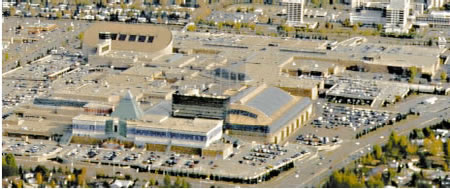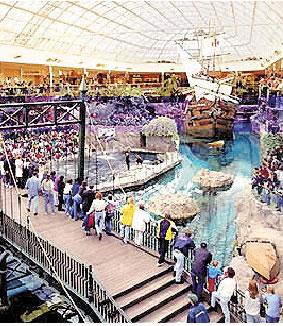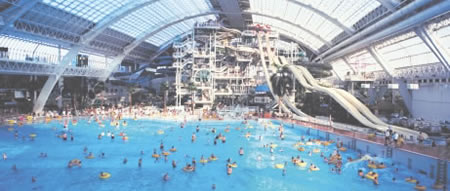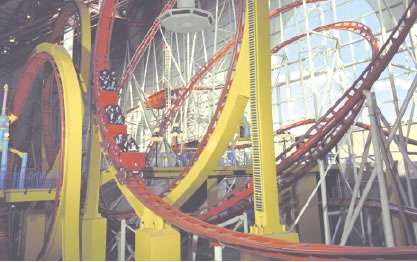West Edmonton Mall: Buying into Energy Efficiency
Please note:
This publication may refer to programs that are no longer available. For current information, please visit ecoENERGY or contact us.

Kevin Hanson, Director of
Operations, West Edmonton Mall
Shopping for energy efficiency
The West Edmonton Mall is a marvel of a mall, with 600 stores and services, and attractions such as a marine life lagoon, a glass-domed skating rink, and the world's largest indoor wave pool and amusement park. As if all that weren't enough, the mall is also working to become a marvel of energy efficiency.
Since the mid-eighties, management has strived to save energy with lighting retrofits, power-factor correction equipment and tenant energy-saving criteria. The mall stepped up efforts in 2001, hiring an energy consultant, creating an energy management division and writing an energy management plan.
“We are looking at lots of ways to save energy that will also provide a return on investment,” says Director of Operations Kevin Hanson, who leads the mall's quest for energy efficiency.
“We have such a large energy bill that we have to pay attention to energy efficiency. By reducing energy consumption and costs, we're also doing what we can to reduce greenhouse gas emissions.”

West Edmonton Mall
Most recently, the West Edmonton Mall installed variable frequency drives (VFDs) on its major HVAC (heating, ventilating and air-conditioning) fans. It did this with assistance from the Energy Innovators Initiative (EII). As part of Natural Resources Canada's Office of Energy Efficiency, the EII works with commercial businesses and public institutions to increase energy efficiency and reduce greenhouse gas (GHG) emissions that contribute to climate change. The West Edmonton Mall has also signed up with Canada's Climate Change Voluntary Challenge and Registry Inc. (VCR Inc.), a non-profit partnership between industry and government that keeps track of reductions in GHG emissions.
Driving home energy savings
A major part of the West Edmonton Mall's VFD retrofit involved the conversion of 42 constant speed, variable-pitch supply and return fans. Now with a fixed pitch, the fans are always in full-air position, and they are hooked up to VFDs attached to existing motors. The retrofit cost about $970,000, but it is expected to save $524,295 a year in energy costs, or about 20 970 GJ annually.
VFDs offer other advantages as well: there is less wear on the motor as a result of reduced speed and torque, gradual acceleration means gentler starting, and there are fewer moving parts because the fan blades don't switch positions.
| Pre-retrofit | Post-retrofit | Savings | |
|---|---|---|---|
| Annual electricity use | 483 407 GJ | 462 437 GJ | 20 970 GJ |
| Annual electricity cost | $9,508,240 | $8,983,945 | $524,295 |
The application for financial assistance from the EII for this retrofit required the West Edmonton Mall to prepare an energy management plan detailing energy-saving projects completed, those in process, and those planned for the future. But this involved more than just taking stock of what has been accomplished and what needs to be done; the very act of going through the proposal form gave Mr. Hanson and his team more ideas on ways to save energy.
“It got us to focus on energy in more general terms,” Mr. Hanson says. “The checklist includes a lot of stuff that doesn't readily come to mind when you think of saving energy, such as certain controls, building envelopes, water heating, and saving natural gas, in addition to saving electricity.”

Pirate Ship, West Edmonton Mall
Spotlight on energy savings
Saving electricity has been a focus of the West Edmonton Mall since 1985, when it invested $50,000 in lighting controls, such as timers and timed bypass systems on all after-hour lights.
Since then, it has continued to adopt energy savings by keeping up with advances in lighting technology. In 1988, it replaced 40-watt fluorescent bulbs with 32-watt miser lamps throughout all common areas, equipment and maintenance rooms and the basement. These 2000 tubes have saved 140 160 kWh, or 505 GJ, per year. Converting incandescent pot lights to compact fluorescent floodlights wherever possible saved another 65 700 kWh, or 236 GJ, per year.
“We wanted to change over as soon as the industry came out with lower-watt bulbs, but they cost more,” Mr. Hanson says. “Because we're a big consumer, we were able to negotiate to get them at the same price as the 40-watt bulbs.”
Two years later, Mr. Hanson and his team were at it again, removing every second general light fixture in the mall's World Waterpark. Removing 50 of its 1000-watt fixtures saved 219 000 kWh, or 788 GJ, per year. Removing every second fixture in areas where lighting was over-designed, such as in rear corridors, saved another 70 080 kWh, or 252 GJ.

World Waterpark, West Edmonton Mall
“We took out a good percentage of light because it was over-lit. Now, not only are we saving on consumption, we're saving on maintenance,” Mr. Hanson says.
In 1999, the West Edmonton Mall implemented its largest energy conservation program to date by retrofitting all fluorescent lighting throughout the facility, including tenant space, at a cost of $826,000. Upgrading over 50 000 T-8 lamps and about 17 000 electronic ballasts led to energy savings of 7 802 842 kWh, or 28 090 GJ, per year. An upside to the retrofit was that all the light fixtures were cleaned at the same time, so the lower-watt lamps did not appear any dimmer.
"Tenants came into their stores and said, 'Wow, this is even brighter than it was!'" Mr. Hanson says.
The lighting for the splash-down area in the World Waterpark was converted to more energy-efficient fixtures in 2001. The replacement of 37 fixtures has saved 84 315 kWh, or 303 GJ, per year.
Existing lighting is now being fine-tuned with new-generation lighting controls and infrared sensors. The West Edmonton Mall is also continuing to convert incandescent lights to compact fluorescent. Along the skylights, it is redesigning the strips of lights that turn on when there isn't enough natural light and is converting them from incandescent to fluorescent.
Exit lights are being converted to LEDs (light-emitting diodes). The 12-storey Fantasyland Hotel is upgrading incandescent lighting to compact fluorescents. This should save 55 607 kWh, or 204 GJ, per year.
Another significant energy saving for the West Edmonton Mall has come from installing power-factor correction equipment to reduce the need for the additional current that's delivered when motors or lighting systems cause electrical current to flow partially out of phase. The first stage of this retrofit, completed in 1988, resulted in energy savings of 4457 kilovars (kVAR) per year. The second stage, in 1996, led to savings of 5360 kVAR per year. Altogether, this equipment reduced the mall's electricity costs by 5 percent.
In January 2001, the mall started implementing power factor controls through the high-intensity discharge (HID) lighting controls through World Energy Contract, saving a total of 1 515 572 kWh, or 5456 GJ, in the Ice Palace and the World Waterpark.
The mall is also working to reduce water consumption. It modified all toilets in common areas and the hotel to a low-flow design in 1996 and insists that tenants do likewise.
Over 800 energy-saving opportunities
If the West Edmonton Mall is to be as energy efficient as possible, more than 600 retail tenants must do their bit. New tenants occupying an area of over 465 square metres are now metered and billed individually. Making tenants aware of their energy costs encourages them to become more active in reducing their energy consumption.

Mindbender, West Edmonton Mall
As for tenants who have power supplied as part of their lease, Mr. Hanson hopes that education will encourage them to save energy – for example, by using energy-efficient lights in spotlights and turning off lights at night.
“We include energy tips in our newsletter to tenants, and we may install meters with digital displays so they can see how much power they're using,” Mr. Hanson says. “Anything we can do to get the costs of operating the facility down is ultimately reflected in our tenants' costs.”
The mall also enforces its leasing agreements as a means of reducing energy consumption. By limiting the design wattage per square metre, these agreements require tenants to use energy-efficient equipment in their designs wherever possible.
As for tenants who have power supplied as part of their lease, Mr. Hanson hopes that education will encourage them to save energy – for example, by using energy-efficient lights in spotlights and turning off lights at night.
“We include energy tips in our newsletter to tenants, and we may install meters with digital displays so they can see how much power they're using,” Mr. Hanson says. “Anything we can do to get the costs of operating the facility down is ultimately reflected in our tenants' costs.”
The mall also enforces its leasing agreements as a means of reducing energy consumption. By limiting the design wattage per square metre, these agreements require tenants to use energy-efficient equipment in their designs wherever possible.
Awareness and accountability
By working environmental issues into its basic orientation and training program, the West Edmonton Mall makes its staff members aware of energy management from the start.
“With a staff of about 1000, it's essential for everyone to understand how important energy efficiency is,” Mr. Hanson says. “If someone notices an inefficiency, we get feedback.”
And the mall gives feedback to employees as well. The accounting department monitors and tracks energy use through a separate cost centre, which has been set up for energy and environmental management.
Energy efficiency wish list
The West Edmonton Mall is evaluating a host of potential projects to increase energy savings even more. In particular, it is trying to figure out a viable way to use gas turbine cogeneration to produce its own electricity on-site.
“We're big enough to consider a cogeneration system,” says Mr. Hanson. “We are always looking at ways to reduce consumption and demand.”
Other projects under examination include:
- converting the wave-generating machine in the World Waterpark from hydraulic to pneumatic
- updating fluid pumps throughout the mall
- adding new controls to water heaters throughout the mall
- converting more than 200 HVAC units from the first phase of the mall to centralized systems
- increasing the efficiency of boilers
- converting chillers to evaporation
- installing a boiler stack economizer to recover heat from hot boiler flue gases and use it to preheat water
- making cooling towers more efficient
- using an infrared scanner to detect heat loss from the mall
- shutting down tenants' gourmet cooking hoods at night
Looking ahead to plans for another hotel or even residential apartments, West Edmonton Mall's team is determined to keep energy costs under control by lowering energy consumption per square metre even as the mall expands.
“We try to do everything as efficiently as possible,” Mr. Hanson says. “That's why we're on the cutting edge of energy efficiency for the retail sector.”
With over 370 000 square metres of gross building area and 22 million visitors a year, the West Edmonton Mall has always been synonymous with big and impressive. So it shouldn't be any surprise that it has taken on energy efficiency in a big way.
You can find other buildings publications from the Office of Energy Efficiency. To order paper copies, or to discuss how we can help you make your property more energy efficient, please contact us.
Office of Energy Efficiency
Natural Resources Canada
580 Booth St., 18th floor
Ottawa ON K1A 0E4
Tel.: 877-360-5500 (toll free)
Fax: 613-947-4121
Web site
West Edmonton Mall
#1784 – 8882, 170 Street
Edmonton AB T5T 4J2
Tel.: 780-444-5261
Fax: 780-444-5335
E-mail: khanson@westedmontonmall.com
Web site: www.wem.ca
Page details
- Date modified: